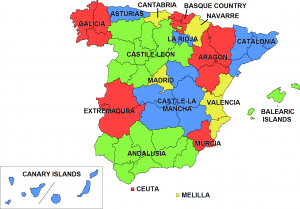By Sarah-Claire Jordan
 If you’ve studied a bit of Spanish history, you’ll know that it’s a country made up of many different regions with their own distinct culture. Some of these regions also have their own languages, like Catalán, Asturian, Galician, and more. Most of these languages are protected under Spanish law and have enjoyed revivals since the end of Franco’s reign. However, there are even more languages spoken in Spain beyond the different regional languages. Here are four different languages you can hear spoken in certain areas of Spain that may surprise you:
If you’ve studied a bit of Spanish history, you’ll know that it’s a country made up of many different regions with their own distinct culture. Some of these regions also have their own languages, like Catalán, Asturian, Galician, and more. Most of these languages are protected under Spanish law and have enjoyed revivals since the end of Franco’s reign. However, there are even more languages spoken in Spain beyond the different regional languages. Here are four different languages you can hear spoken in certain areas of Spain that may surprise you:
1. Fala
Fala, which means “speech” in the Fala language, is a Romance language that belongs to the Portuguese-Galician language group. It shares many characteristics with Portuguese and Galician, and even though it is mutually intelligible with Galician, is still considered a separate language with its own orthography. Fala is spoken in the northwestern part of the autonomous community of Extremadura. It doesn’t have much visibility, even in the church or schools, but the Fala speaking community has a 100% literacy rate.
2. Judaeo-Spanish
Often referred to as “Ladino”, Judaeo-Spanish traces its roots back to Spain, though it isn’t generally spoken there. It is a Romance language that is derived from Old Spanish and was originally spoken in what used to be the Ottoman Empire, which would include Turkey, parts of the Middle East and North Africa, and the Balkans. It can be found in other European and Mediterranean countries as well, but the highest concentration of speakers live in Israel. The vocabulary of Ladino includes many elements from Old Catalan, Old Portuguese, and more.
3. Riffian Berber
Part of the Afro-Asiatic language family, Riffian Berber, also referred to as simply Riffian or Rif Berber, is spoken in the Spanish city of Melilla, which is in North Africa. Melilla shares a border with Morocco and is one of two Spanish cities in North Africa. Riffian is a dialect of Zenati Berber, and has been written using many different writing systems. The Arabic script used to be common for writing Riffian Berber, but nowadays it isn’t used. Online, you’ll find publications written using the Berber Latin alphabet. Unfortunately, very little was written in Riffian Berber before the 1900s, so we don’t have much information on the language beyond that time.
4. Silbo Gomero
The last language on this list is an extremely interesting one, as it is a whistled language. Silbo Gomero is essentially a whistled version of the dialect of Spanish spoken on the Canary Islands. It is traditionally used by those who live in La Gomera on the islands as a way to communicate information from far away without the use of phones, etc. Messages can be “sent” back and forth for a distance of up to 5 kilometers. It is mostly used to communicate public information, like an event that everyone in the town is invited to, or something that everyone in the community should know about. Silbo Gomero tries to mimic the set of sounds used in Spanish with the limited amount of sounds one can make whistling. Pitch and the duration of the whistled sound are used to differentiate words, but confusion still happens once in a while due to the limited nature of the sounds used.
For an overview of our translation expertise, visit our media and marketing translation page.



